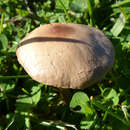en
names in breadcrumbs


Panaeolus foenisecii, commonly called the mower's mushroom, haymaker or brown hay mushroom, is a very common and widely distributed little brown mushroom often found on lawns and is not an edible mushroom. In 1963 Tyler and Smith found that this mushroom contains serotonin, 5-HTP and 5-hydroxyindoleacetic acid.[2] In many field guides it is listed as psychoactive; however, the mushroom does not produce any hallucinogenic effects. [3]
The species may be the most common to appear in lawns in the Pacific Northwest.[5] It is also found on lawns along the east coast.
The following two images are of Panaeolus foenisecii in the wild with two magnifications of the spore print.
Similar species include Agaricus campestris, Conocybe apala, Marasmius oreades, Psathyrella candolleana, and Psathyrella gracilis.[4]
It is sometimes mistaken for the psychedelic Panaeolus cinctulus or Panaeolus olivaceus, both of which share the same habitat and can be differentiated by their jet black spores. This is probably why Panaeolus foenisecii is occasionally listed as a psychoactive species in older literature.
Panaeolus foenisecii, commonly called the mower's mushroom, haymaker or brown hay mushroom, is a very common and widely distributed little brown mushroom often found on lawns and is not an edible mushroom. In 1963 Tyler and Smith found that this mushroom contains serotonin, 5-HTP and 5-hydroxyindoleacetic acid. In many field guides it is listed as psychoactive; however, the mushroom does not produce any hallucinogenic effects.